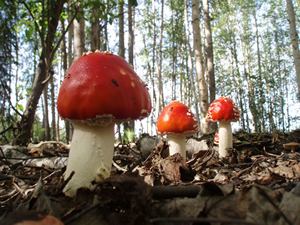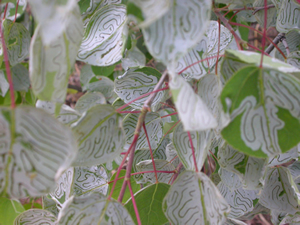Squirrels and toxic mushrooms; aspens and leaf miners
Squirrels and toxic mushrooms; aspens and leaf miners
Submitted by Ned Rozell
Phone: 907-474-7468
09/06/07

Download photo

Download photo
Fairbanks reader darleen masiak recently saw a red squirrel carrying an Amanita mushroom across her deck, presumably to stash it in its midden for the winter. She wanted to know how such a small mammal could survive after eating a mushroom that is toxic in large doses.
Fungus expert Gary Laursen of the University of Alaska Fairbanks confirmed that forest squirrels, both red and flying, cache Amanita mushrooms as well as other "psychoactive" mushrooms that affect the central nervous system. He has dug into squirrel middens in the boreal forest and has found many samples of the mushrooms. He said a biologist recently contacted him and told he’d seen grouse digging up and eating mushrooms that would be toxic in large doses to humans.
"Many animals are known to go after the psychoactive ’shrooms," Laursen said.
Brian Barnes, a physiologist and the director of the Institute of Arctic Biology, said a squirrel’s liver might be able to detoxify the active agents in the mushrooms, but he knows of no evidence for this. Barnes studies arctic ground squirrels on Alaska’s North Slope. He thinks young male ground squirrels might be eating lots of fungi, including potent ones, as they stir in their dens from hibernation. The squirrels often emerge from hibernation fatter than when they went in.
"I wonder if, while in their cold and completely dark hibernaculum, arctic ground squirrels are eating psychoactive mushrooms and whether they respond by experiencing hallucinations, feelings of well being, and laughing fits, as do humans (or so I’m told)," Barnes wrote in an e-mail.
An explosion of insects that attack quaking aspen trees has left the leaves so silvery that it is hard to remember when they were dark green, but the damaged leaves might not hurt the trees as much as people think.
Caterpillars known as aspen leaf miners have hit almost every tree in the Interior and many throughout Alaska during a recent outbreak, cutting mazes beneath the surfaces of leaves.
When biologists checked out a sample of 90 aspens last year, 99 percent of the trees had at least some leaf-miner damage. Seeing those numbers, and by looking around at the silvery aspens in Alaska for the past three or four years, a person might assume that the trees are goners. How could they take such hits to their solar panels year after year and still grow?
"Working with Linda DeFoliart and Jenny Schneiderheinze, we found that mining by the aspen leaf miner on the tops of aspen leaves has little or no effect on photosynthesis," said Diane Wagner, a University of Alaska insect and plant ecologist who, with fellow UAF professor Pat Doak, has studied the leaf-miners’ effects on the aspen. "The caterpillar eats only the cells of the epidermis, the outer layer of the leaf, not the photosynthetic cells of the interior."
When leaf miners work the bottoms of aspen leaves, they do reduce photosynthesis, because leaf mining on the underside damages stomata, pores through which plants take in carbon dioxide.
This column is provided as a public service by the Geophysical Institute, University of Alaska Fairbanks, in cooperation with the UAF research community. Ned Rozell is a science writer at the institute. To view past columns or to subscribe, visit www.gi.alaska.edu/ScienceForum/index.html.


